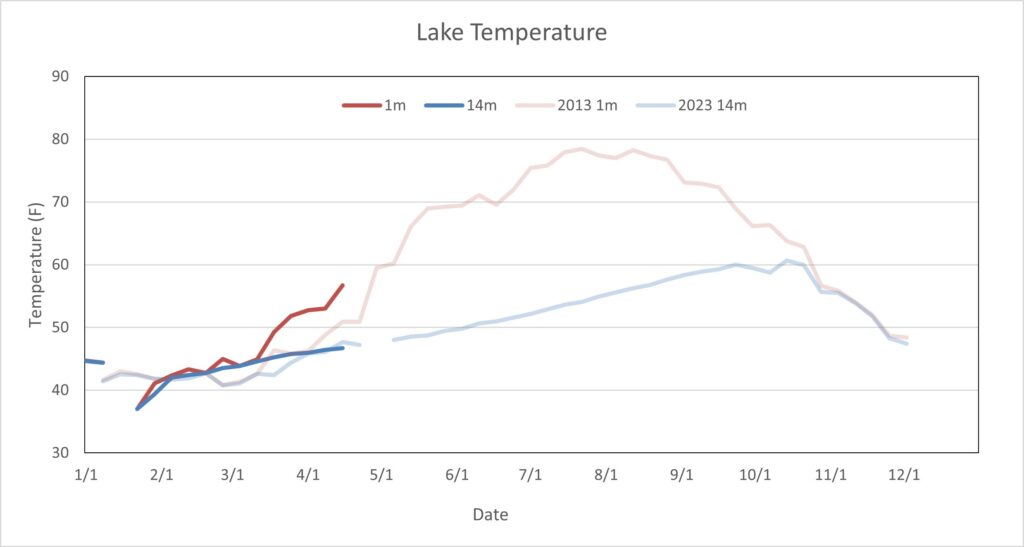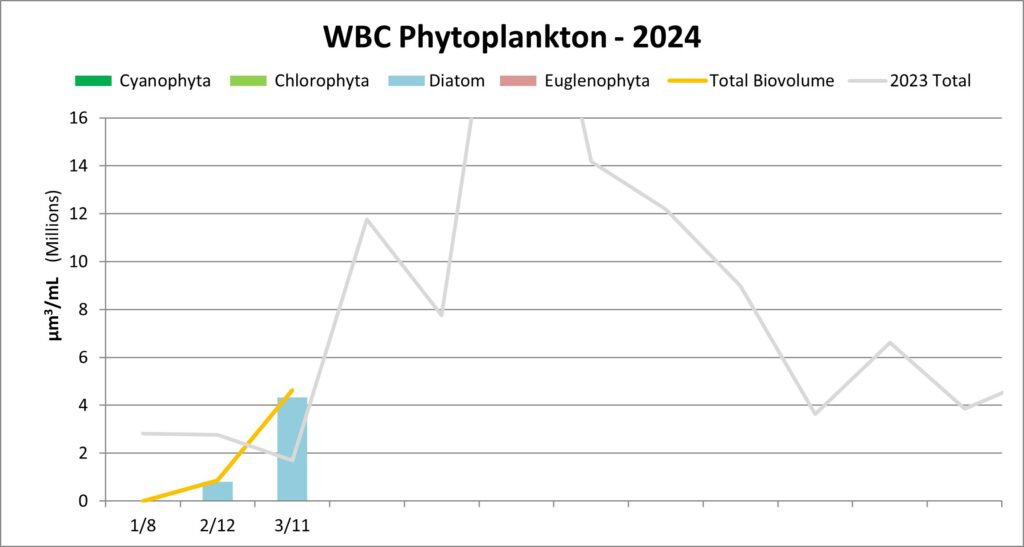The Lake Oswego Corporation (LOC) has a longstanding water quality program with a goal of reducing harmful cyanobacteria blooms and stopping the introduction of invasive species. We accomplish this by having a robust program of testing and monitoring to guide our efforts. We began weekly testing and data collection in the early 1990s and have had a full-time limnologist on staff since 1999. To reduce the threat of zebra mussel, quagga mussel, and milfoil introductions, in 2000 the LOC initiated a (novel at the time) boat tagging and decontamination program which continues to this day.
Sampling data led the LOC to initiate several water quality improvement projects over the years with the goal of reducing phosphorus to a point where cyanobacteria are not the dominant phytoplankton population. These projects included reducing flow from the Tualatin River, installing hypolimnetic aeration, formulating phosphorus-free fertilizer for lakeside residents, dredging high-nutrient sediment, reducing leaks through our hydroelectric plant, and treating incoming water and the lake with aluminum sulfate. All of which have greatly enhanced water quality by reducing cyanobacteria blooms.
However, with climate change making our summers warmer and winter weather more extreme we cannot claim victory. We must continue to adapt our systems to the new weather reality and research new technologies in our effort to reduce phosphorus. This means working with the city of Lake Oswego on improving the local watershed and collaborating with organizations in the Tualatin River basin to monitor and improve our source water.
There are several ongoing projects within Oswego Lake that we are working on. We periodically post updates on these projects on our News page. Follow our efforts to improve water quality and wildlife habitat in Oswego Lake and the watershed.
Resources for Homeowners to Help Us Maintain Water Quality
Moss Control for Roofs and Decks
To maintain the quality of Oswego Lake, it’s essential to follow certain protocol when preventing and treating moss on your roof and deck.
TO PREVENT MOSS GROWTH
- Keep roofs clean by sweeping and blowing away debris when the weather is dry.
- Apply baking soda along the ridge line in late summer to raise the pH and deter moss growth.
TREATING EXISTING MOSS
- Use baking soda or d-limonene-based products to treat moss.
- Gently remove moss with a wire or nylon brush after it dies off.
AVOID THESE TREATMENT PRODUCTS
- ZINC – Toxic to fish
- POTASSIUM SALTS OF FATTY ACIDS – Toxic to aquatic invertebrates
- OXIDIZING BLEACHING AGENTS WITHOUT CHLORINE – Hazardous to water due to presence of other bleaching agents, such as hydrogen peroxide, sodium percarbonate and sodium perborate.
If you do use these products, try to do so during the dry season to minimize chemical runoff. You can also disconnect downspouts during application and cleaning to allow the wash to infiltrate the soil.
Deck Sealers and Stains
It is important to use deck sealers and stains that help keep harmful chemicals out of Oswego Lake.
We recommend the following products:
Timber Pro Deck & Fence Formula – locally made in Portland
Eco Safety Products – Soy-based stains and sealers
About Cyanobacteria
Cyanobacteria is also called “harmful algae” although it’s not actually algae! This bacteria is found naturally in bodies of water and only become a problem when they proliferate and “bloom.” These blooms produce cyanotoxins that can be harmful to humans and pets.
We highly recommend reading more about cyanobacteria on the Oregon Health Authority website.
Current Water Quality Data
April 16, 2024
Our spring weather is here and the watershed is getting green! Thankfully the lake is not green since this is the time of year when water clarity really increases. You will be able to see that in the Secchi data below.
Lake Temperature
The water temperature has increased a lot this past month, and is much warmer than it was last year at this time. In 2023 the water temperature was 51 degrees this time of year, but it has reached 57 degrees this year. The warmer water and sunny conditions may affect our lake ecology by shifting our diatom bloom and clear water phase earlier this spring.

Secchi
This is the time of year with the best water clarity, and it has been increasing over the past month. We are seeing 17 feet down into the water column as of April 15 so we will see if we exceed the 19 feet we saw last year.

Phytoplankton
Phytoplankton biovolume is shown for the three main basins all on the same scale so you can see how one compares to the other. We only have a few data points to draw from, but West Bay and Lakewood Bay seem to be less active than Main Lake. Lakewood Bay has very low algae biomass so far this spring, with it barely showing on the graph.

Diatoms were very active in February and March, but by the end of March the population had declined dramatically. This is typical this time of year when zooplankton become active and consume most algae in the lake. This is the start of our “clear water phase” and the reason for the high Secchi readings you saw in the second graph.

West Bay is always full of diatoms year around. While this impedes water clarity it also limits plant and cyanobacteria growth. If this shallow bay were maintained for clear water we would be constantly treating aquatic plants and may have to contend with cyanobacteria. The bay does occasionally see cyanobacteria, but that is primarily due to it blowing in from the Main Lake.
